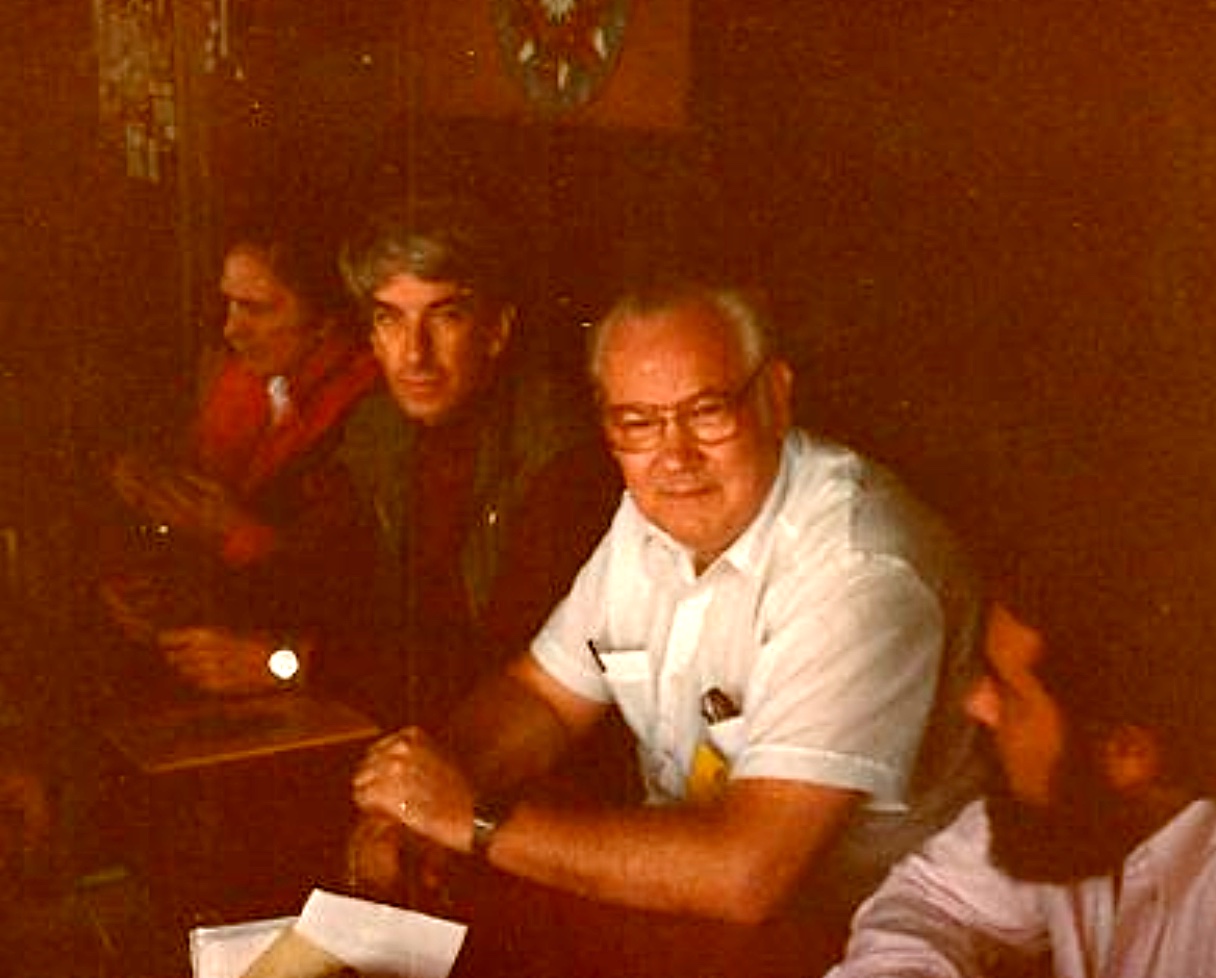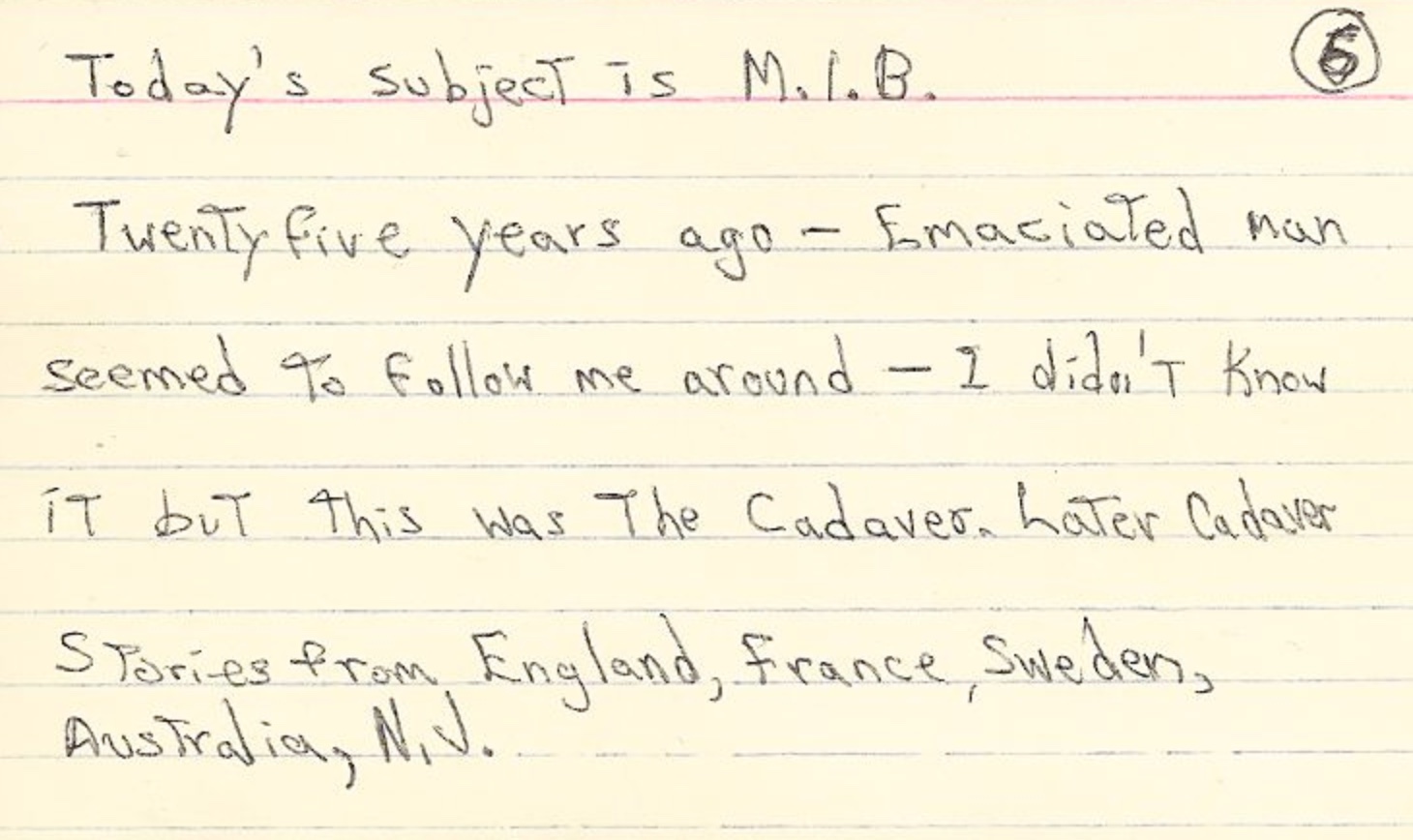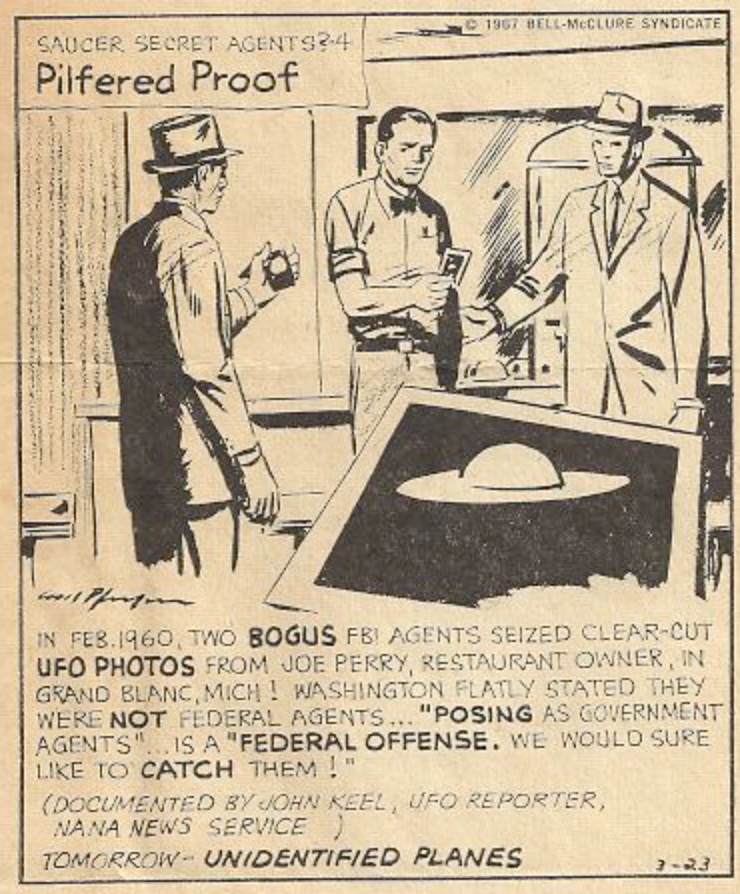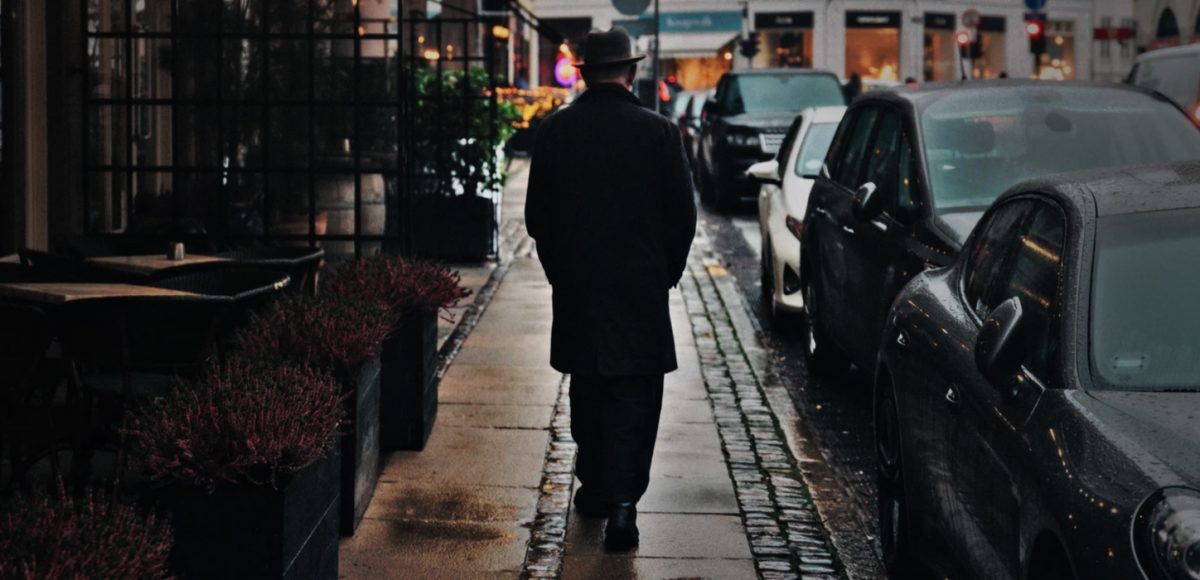During the 1960s, American author and UFO researcher John Keel had a problem: it involved reports of Men in Black, the mysterious strangers in dark suits said to appear after UFO sightings and intimidate witnesses.
Over the years, Keel told of arriving at the homes of UFO witnesses only a short time after they had been visited by these odd individuals, who were often described as having an olive complexion and stiff, almost robotic demeanor. The men were known for asking strange questions, and in some instances, the Men in Black even acted in an angry or threatening manner toward witnesses they approached.

Keel, unable to prove who the Men in Black (MIBs) were, nonetheless viewed these strangers as a focal point of the UFO mystery. “I realized that I would never be able to catch a flying saucer,” Keel wrote in his book The Eighth Tower, “but if the MIB were real, and the testimony of many people indicated they were, I might be able to head them off at some cosmic pass, and force their big black automobile to the side of the road.”
On a few occasions, Keel said he observed the “phantom Cadillacs” that he believed to have belonged to the Men in Black. Once on Long Island, he told of receiving an anonymous phone call he recieved which resulted in him confronting and chasing one of the cars, only to have had it disappear inexplicably on a dead-end road. Keel described these “phantom” automobiles as having “sinister-looking” passengers, who often had a foreign appearance.
So who were these ominous observers of the UFO phenomenon? Are stories of “Men in Black” really just folklore that has been built onto some of the unusual characters that ran in UFO circles throughout the 1960s? Or could some of them have a more down-to-earth explanation, which might even involve investigations by the U.S. Air Force during the years of Project Blue Book?

In at least a few cases, it appears that some individuals Keel described as Men in Black in his books over the years turned up in other situations and were able to be identified. One notable example is a MIB Keel gave the nickname “Tiny”, who had a penchant for odd mannerisms and wearing a Russian-style fur hat. After Keel wrote about this “MIB” in his book The Mothman Prophecies, Charles Bowen, editor of Flying Saucer Review, wrote to Keel noting that a man possessing the same unmistakable characteristics came to visit him in the United Kingdom. Unlike in previous instances Keel had written about, his name was well known to Bowen. “Tiny” even stayed with the Bowen family during his short stay in England, who Bowen said “regarded him rather as they might do a cobra, and expressed a feeling of repugnance” toward him.
PODCASTS: John Keel and the Men in Black
Another instance where Keel wrote about a visit from an alleged MIB appeared in chapter two of The Mothman Prophecies, titled “The Creep Who Came in from the Cold.” In it, Keel describes an incident that took place in May 1967, where a purported MIB visited a Mrs. Ralph Butler of Owatonna, Minnesota. In this famous case, which Keel would refer to many times over the years in his lectures and other appearances, the MIB in question attempted to pick up a bowl of Jell-O and drink it:
“Did you ever hear of anyone—especially an air force officer—trying to drink Jell-O?” [Butler] asked. “Well, that’s what he did. He acted like he had never seen any before. He picked up the bowl and tried to drink it. I had to show him how to eat it with a spoon.”
In this case, the MIB introduced himself as “Major Richard French of the U.S. Air Force,” and was said to have arrived in a white Ford Mustang. He was wearing civilian clothes, described later to John Keel as a “neat gray suit,” and that “everything else he was wearing appeared to be brand-new,” including the un-scuffed soles of his shoes. Mrs. Butler told Keel that French was “about five feet nine inches tall, with an olive complexion and a pointed face. His hair was dark and very long—too long for an air force officer.” Mrs. Butler found him to be a fluent conversationalist until at one point he complained of having stomach trouble. “When Mrs. Butler offered him the Jell-O,” Keel notes of the bizarre visit, “she suspected for the first time that something was out of kilter.”
Keel rather bluntly asserted that “Major Richard French” was not at all who he claimed to be:
Richard French was an imposter. One of the many wandering around the United States in 1967. For years these characters had caused acute paranoia among the flying saucer enthusiasts, convincing them that the air force was investigating them, silencing witnesses and indulging in all kinds of unsavory activities—including murder. When I first began collecting such reports I was naturally suspicious of the people making such reports. It all seemed like a massive put-on. But gradually it became apparent that the same minute details were turning up in widely separated cases, and none of these details had been published anywhere … not even in the little newsletters of the UFO cultists.
So who was Richard French, and is it possible that this MIB “impostor” might have actually been with the U.S. Air Force?

Decades later, answers to these questions might have turned up unexpectedly at the Citizens Hearing on Disclosure, an event held at the National Press Club in Washington in 2013. According to the event’s website, “Forty researchers along with military/agency/political persons of high rank and station came to the National Press Club in Washington, DC to testify to six former members of the United States Congress.”
A Washington Post article that covered the event noted that a retired Air Force colonel now in his 80s had been one of the men who testified at the event, describing him thusly:
“An Air Force colonel now in his 80s, Richard French, claimed to have been responsible for covering UFOs up. “I’d say it was swamp gas. Anything we could come up with to convince the general public. At that time there was an average of about three a week ufos… I went down there observed ’em just regularly.”
“Why is it now that you’re at the table?” asked former congresswoman Carolyn Kilpatrick.
“PROBABLY IT’S BECAUSE I’M IN MY 80s,” French said.
A Huffington Post article by Lee Spiegel also discussed the testimony French gave at the event in 2013, referring to him as, ”an alleged lead investigator of Project Blue Book in the 1950s.”
As Spiegel wrote at the time:
In Washington, D.C., recently, the 83-year-old retired officer testified at the Citizen Hearing On Disclosure panel of six former members of Congress about his work as a UFO debunker in 1952. French recounted how the Newfoundland incident unfolded decades ago, in the early 1950s, after two UFOs were seen by many people off the coast of St. John’s. French’s superiors ordered him to look into the situation.

Even prior to his appearance at the 2013 Citizen’s Hearing and subsequent media attention he received, a photo which appears to show a young lieutenant French in Air Force uniform was featured in a 2012 OpenMinds article, where writer and editor Antonio Huneeus expressed some skepticism about French’s claims about UFO investigations during the Blue Book era. However, what can be verified about French, according to records that were uncovered by Huneeus, is that he participated in Air Force operations including more than 600 missions during conflicts including the Korean War. French had also worked with the Air Force Office of Special Investigations (OSI), which was later referred to by ufologist Bill Moore as the agency from which many modern urban legends about “Men in Black” may have their origin.
According to Keel, several of the Men in Black had likely been posing as “military officers,” but serving the actual purpose of confusing the public, as well as ridiculing and intimidating UFO witnesses. In light of French’s claims in 2013 that he had once served as a UFO “debunker” for Project Blue Book, perhaps Keel was partially right: French may not have been a full-blown impostor, but if his claims are true, he certainly had been working to cover up the extent that UFO sightings were occurring in America at that time.
In any case, it seems that another of John Keel’s famous “MIBs” from the late 1960s has been positively identified, and very likely had been involved in UFO investigations undertaken by the U.S. Air Force at that time.
For more information about John Keel and his work, visit JohnKeel.com, a website maintained by Keel’s longtime friend Doug Skinner.
This article originally appeared in the TSL Telepath Newsletter.



